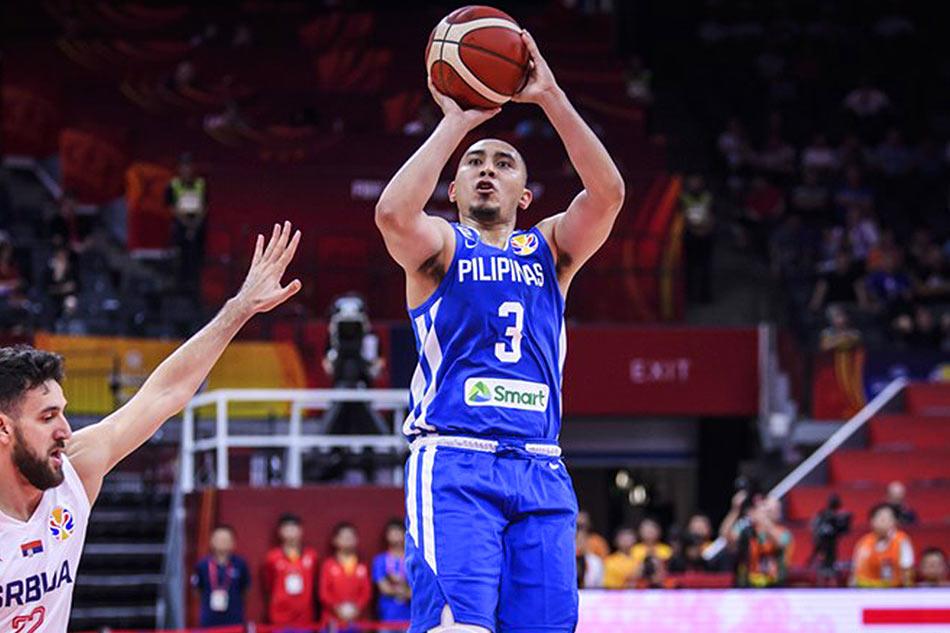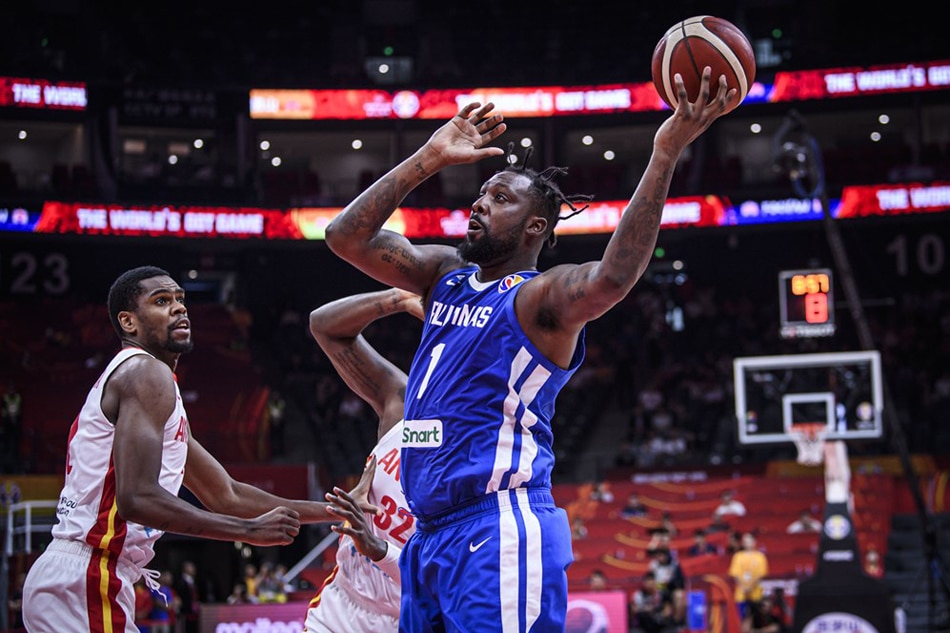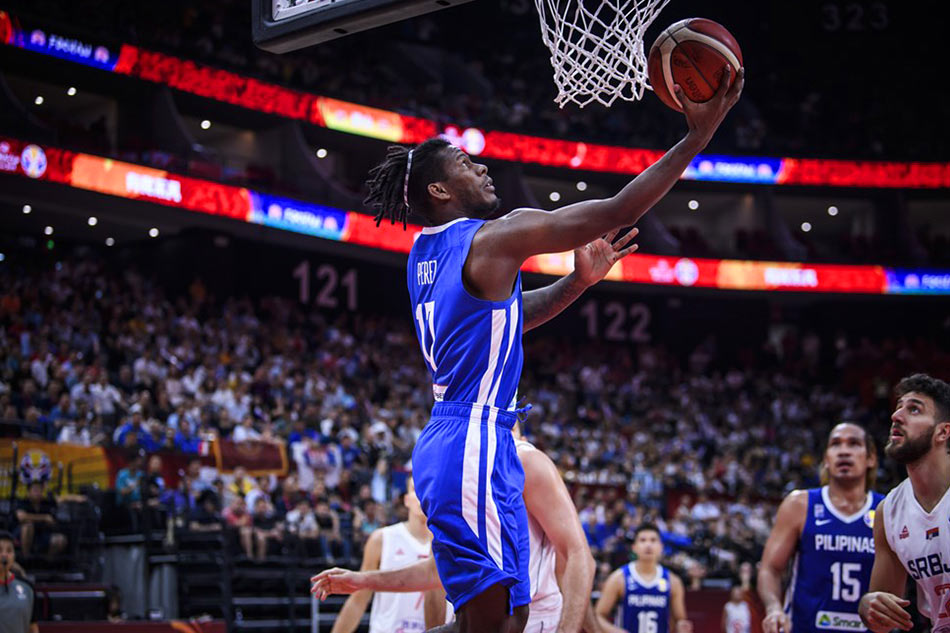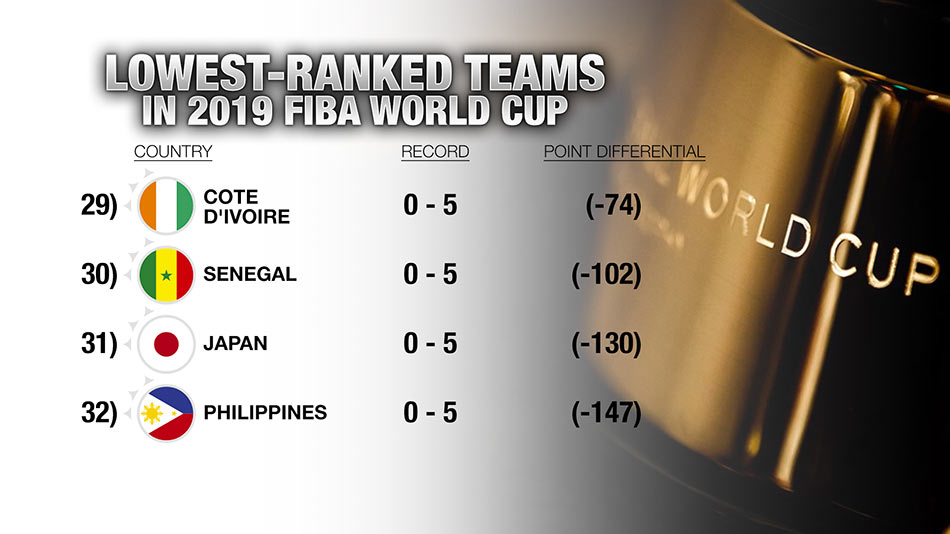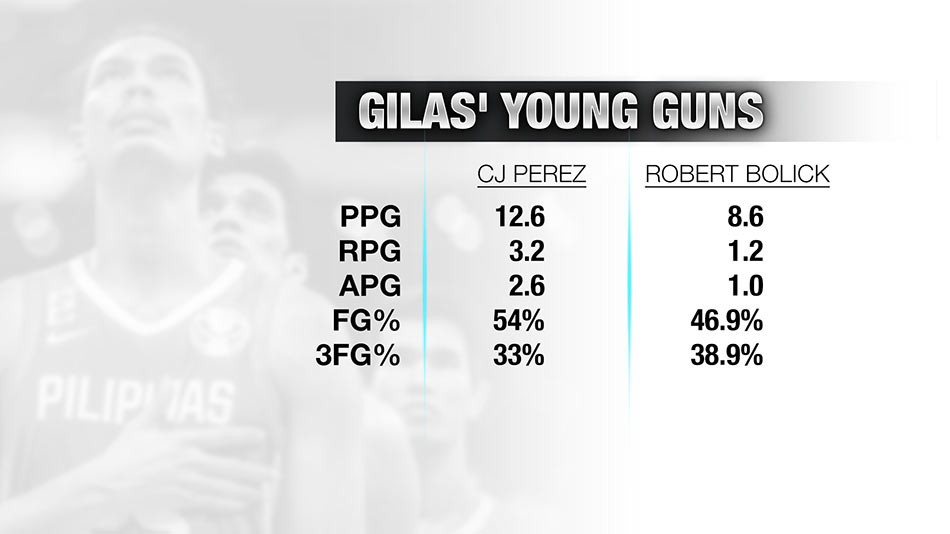Numbers explain why Gilas PH finished dead last in 2019 FIBA World Cup | ABS-CBN
ADVERTISEMENT

Welcome, Kapamilya! We use cookies to improve your browsing experience. Continuing to use this site means you agree to our use of cookies. Tell me more!
Numbers explain why Gilas PH finished dead last in 2019 FIBA World Cup
Numbers explain why Gilas PH finished dead last in 2019 FIBA World Cup
Edson Guido,
ABS-CBN Data Analytics Team
Published Sep 11, 2019 05:34 PM PHT
|
Updated Sep 12, 2019 01:07 AM PHT
MANILA -- After going 0-5 in the 2019 FIBA World Cup, Gilas Pilipinas is set to finish in last place--a stunning setback for the basketball-crazy nation.
MANILA -- After going 0-5 in the 2019 FIBA World Cup, Gilas Pilipinas is set to finish in last place--a stunning setback for the basketball-crazy nation.
In terms of the win-loss record, the Philippines was not alone.
In terms of the win-loss record, the Philippines was not alone.
Japan, Senegal, and Cote d'Ivoire all ended up without a single win, but the Philippines was ranked last due to its inferior -147 point differential in five games (Japan finished 31st with -130, Senegal 30th with -102, and Cote d'Ivoire 29th with -74). That's the total number of points the Philippines lost by.
Japan, Senegal, and Cote d'Ivoire all ended up without a single win, but the Philippines was ranked last due to its inferior -147 point differential in five games (Japan finished 31st with -130, Senegal 30th with -102, and Cote d'Ivoire 29th with -74). That's the total number of points the Philippines lost by.
In the last World Cup held in 2014, Gilas Pilipinas finished 21st out of the 24 teams, with a 1-4 record against what is arguably a tougher draw. It was competitive against Argentina (ranked 3rd at that time), Greece (ranked 5th), Croatia, Puerto Rico, and Senegal.
In the last World Cup held in 2014, Gilas Pilipinas finished 21st out of the 24 teams, with a 1-4 record against what is arguably a tougher draw. It was competitive against Argentina (ranked 3rd at that time), Greece (ranked 5th), Croatia, Puerto Rico, and Senegal.
ADVERTISEMENT
The ABS-CBN Data Analytics team looked at the numbers for the first two rounds of the 2019 World Cup Tournament, before the knockout stages, to provide an objective analysis.
The ABS-CBN Data Analytics team looked at the numbers for the first two rounds of the 2019 World Cup Tournament, before the knockout stages, to provide an objective analysis.
Horrible 3-pt shooting
Before the tournament started, everyone knew how important 3-point shooting would be for the Philippines. As one of the shortest teams, Gilas needed to be accurate behind the arc to draw out taller defenders, and give smaller Filipino players better scoring opportunities. In 2014, the Philippines averaged nearly nine 3-point conversions per game, 7th highest in the tournament (even ahead of the highly favored team USA).
Before the tournament started, everyone knew how important 3-point shooting would be for the Philippines. As one of the shortest teams, Gilas needed to be accurate behind the arc to draw out taller defenders, and give smaller Filipino players better scoring opportunities. In 2014, the Philippines averaged nearly nine 3-point conversions per game, 7th highest in the tournament (even ahead of the highly favored team USA).
This year, Gilas only converted a quarter (25.2 percent) of its 3-point looks, the second worst 3-point clip in the 32-team tournament. In their first game against Italy, Gilas missed its first 17 3-point attempts. Making outside shots was the game changer in that game as it was virtually over at the end of the first quarter when Team Azzurri led 37-8.
This year, Gilas only converted a quarter (25.2 percent) of its 3-point looks, the second worst 3-point clip in the 32-team tournament. In their first game against Italy, Gilas missed its first 17 3-point attempts. Making outside shots was the game changer in that game as it was virtually over at the end of the first quarter when Team Azzurri led 37-8.
What's worse, the dismal shooting did not prevent the Philippines from firing away from downtown, averaging 28.6 attempts per game, 6th most in the FIBA World Cup. In the Angola game, Gilas even attempted more 3-pointers (46) compared to 2-point field goals (41).
What's worse, the dismal shooting did not prevent the Philippines from firing away from downtown, averaging 28.6 attempts per game, 6th most in the FIBA World Cup. In the Angola game, Gilas even attempted more 3-pointers (46) compared to 2-point field goals (41).
Because of the team's inability to generate offense, Gilas Pilipinas only averaged 70.4 points per game, tied with Jordan for 25th in the tournament. In 2014, Gilas averaged 76.6 points per game, good for 13th place out of the 24 teams in the tournament (and #1 in Asia).
Because of the team's inability to generate offense, Gilas Pilipinas only averaged 70.4 points per game, tied with Jordan for 25th in the tournament. In 2014, Gilas averaged 76.6 points per game, good for 13th place out of the 24 teams in the tournament (and #1 in Asia).
ADVERTISEMENT
Defense
With an anemic offense, Gilas had to rely on its defense to be competitive. The pressure was too much and the defense cracked. Gilas allowed Serbia to score the most number of points in the 2019 FIBA World Cup (126 points) so far. This was also the worst World Cup loss for the Philippines ever.
With an anemic offense, Gilas had to rely on its defense to be competitive. The pressure was too much and the defense cracked. Gilas allowed Serbia to score the most number of points in the 2019 FIBA World Cup (126 points) so far. This was also the worst World Cup loss for the Philippines ever.
In the game before that, Gilas gave up 108 points to Italy, the 4th highest output of the tournament. Overall, the Philippines allowed their opponents to score nearly a hundred points per game (99.8), easily the worst mark in the competition.
In the game before that, Gilas gave up 108 points to Italy, the 4th highest output of the tournament. Overall, the Philippines allowed their opponents to score nearly a hundred points per game (99.8), easily the worst mark in the competition.
In 2014, three of the Philippines' four losses were within 5 points. Their worst game of the tournament was against Greece, a 12-point loss, 82-70. Gilas' defense only allowed 80.8 points per game during that time, with only one team scoring more than 83 points (Argentina scored 85). In contrast, all opponents of Gilas in 2019 scored at least 84 points.
In 2014, three of the Philippines' four losses were within 5 points. Their worst game of the tournament was against Greece, a 12-point loss, 82-70. Gilas' defense only allowed 80.8 points per game during that time, with only one team scoring more than 83 points (Argentina scored 85). In contrast, all opponents of Gilas in 2019 scored at least 84 points.
The average margin of losses in 2014 was 4.2 points. In 2019? A whopping 29.4 points.
The average margin of losses in 2014 was 4.2 points. In 2019? A whopping 29.4 points.
Assist-to-turnover ratio
While other teams were whipping the ball around to generate easy baskets, Gilas was fumbling the ball around, generating easy baskets for opponents. Gilas was one of only three teams to average more turnovers (15.0) than assists (13.2) with the Philippines ranking third in the tournament in terms of turnovers.
While other teams were whipping the ball around to generate easy baskets, Gilas was fumbling the ball around, generating easy baskets for opponents. Gilas was one of only three teams to average more turnovers (15.0) than assists (13.2) with the Philippines ranking third in the tournament in terms of turnovers.
ADVERTISEMENT
Andray Blatche
Naturalized player Andray Blatche was the team's anchor, leading the team in points (15.8), rebounds (8.4), assists (3.4), steals, blocks and minutes played. He also led Gilas in most of these categories in 2014, but the difference in the totals was stark.
Naturalized player Andray Blatche was the team's anchor, leading the team in points (15.8), rebounds (8.4), assists (3.4), steals, blocks and minutes played. He also led Gilas in most of these categories in 2014, but the difference in the totals was stark.
In 2014, Blatche led the tournament in rebounds, averaging 13.8 per game, while also being the 2nd top scorer at 21.2 points per game. Evidently, there was a considerable drop in his performance this time around. He also committed the most turnovers in the tournament (4.4 per game) and had the worst plus-minus in the team (-24.4). In other words, despite all of his contributions, Gilas still fell behind by an average of over 24 points with Blatche on the floor.
In 2014, Blatche led the tournament in rebounds, averaging 13.8 per game, while also being the 2nd top scorer at 21.2 points per game. Evidently, there was a considerable drop in his performance this time around. He also committed the most turnovers in the tournament (4.4 per game) and had the worst plus-minus in the team (-24.4). In other words, despite all of his contributions, Gilas still fell behind by an average of over 24 points with Blatche on the floor.
Silver lining
In the 2014 World Cup, no other Gilas player averaged in double digits outside of Andray Blatche. In 2019, however, CJ Perez was able to provide that consistent support averaging 12.6 points in less than 20 mins per game. He also made 54 percent of his shots and was the only player in the team to convert at least half of his attempts.
In the 2014 World Cup, no other Gilas player averaged in double digits outside of Andray Blatche. In 2019, however, CJ Perez was able to provide that consistent support averaging 12.6 points in less than 20 mins per game. He also made 54 percent of his shots and was the only player in the team to convert at least half of his attempts.
To put Perez's shooting performance into perspective, seven out of the 12 Philippine players shot below 40 percent from the field. Consequently, Gilas shot 38.3 percent, the 4th lowest mark in the tournament.
To put Perez's shooting performance into perspective, seven out of the 12 Philippine players shot below 40 percent from the field. Consequently, Gilas shot 38.3 percent, the 4th lowest mark in the tournament.
Robert Bolick was the team's 3rd leading scorer. He led the team in 3-point shooting percentage, making 39 percentage of his shots from beyond the arc. He was also 2nd on the team in 3-point conversions, averaging 1.4 makes per game in 14 minutes of playing time.
Robert Bolick was the team's 3rd leading scorer. He led the team in 3-point shooting percentage, making 39 percentage of his shots from beyond the arc. He was also 2nd on the team in 3-point conversions, averaging 1.4 makes per game in 14 minutes of playing time.
ADVERTISEMENT
The performances of Perez and Bolick were definitely impressive, considering the two PBA rookies were also competing for the first time in the international scene. This is something the team can definitely build on moving forward.
The performances of Perez and Bolick were definitely impressive, considering the two PBA rookies were also competing for the first time in the international scene. This is something the team can definitely build on moving forward.
Finally, despite the disheartening results of 2019, the Philippines is still assured of a spot as the hosts at the next FIBA World Cup in 2023. With this year's performance, the team can figure out the areas where it can improve on in the next four years. The team can also tinker with the roster to find players who can improve the team's 3-point shooting, defense and ball movement.
Finally, despite the disheartening results of 2019, the Philippines is still assured of a spot as the hosts at the next FIBA World Cup in 2023. With this year's performance, the team can figure out the areas where it can improve on in the next four years. The team can also tinker with the roster to find players who can improve the team's 3-point shooting, defense and ball movement.
Below are pertinent numbers on Gilas' performance in the 2019 FIBA World Cup:
Below are pertinent numbers on Gilas' performance in the 2019 FIBA World Cup:
Source of raw data: FIBA World Cup
For more sports coverage, visit the ABS-CBN Sports website.
For more sports coverage, visit the ABS-CBN Sports website.
ADVERTISEMENT
ADVERTISEMENT



